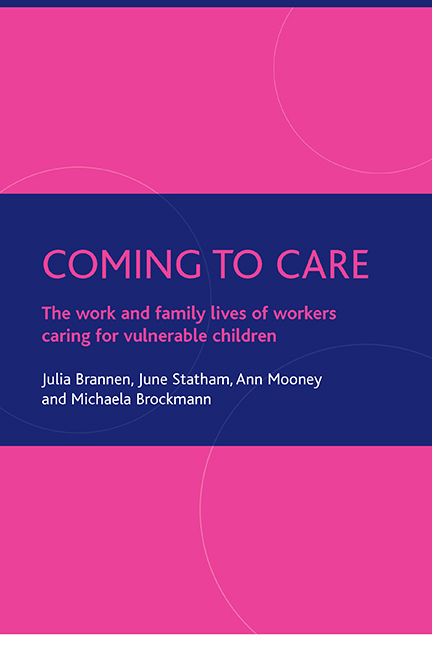Book contents
- Frontmatter
- Contents
- List of tables and boxes
- Acknowledgements
- one Setting the scene
- two The study
- three The origins of a care ethic in care workers’ childhoods
- four Entering care work with vulnerable children
- five Care workers’ careers and identities: change and continuity
- six What do vulnerable children need? Understandings of care
- seven Experiences of care work
- eight Leavers, movers and stayers
- nine Managing care work and family life
- ten Conclusions and policy implications
- Appendix: Boxes and additional tables
- References
- Index
two - The study
Published online by Cambridge University Press: 15 September 2022
- Frontmatter
- Contents
- List of tables and boxes
- Acknowledgements
- one Setting the scene
- two The study
- three The origins of a care ethic in care workers’ childhoods
- four Entering care work with vulnerable children
- five Care workers’ careers and identities: change and continuity
- six What do vulnerable children need? Understandings of care
- seven Experiences of care work
- eight Leavers, movers and stayers
- nine Managing care work and family life
- ten Conclusions and policy implications
- Appendix: Boxes and additional tables
- References
- Index
Summary
Introduction
This chapter describes the study's research questions, how its research design addressed these questions, the different phases of the study, the variety of different methods used and the characteristics of the childcare workers who participated.
The study's research questions
The main research questions addressed by the study are:
• What shaped an ethic of care among different groups working with vulnerable children, in particular residential care workers, family support workers, foster carers and community childminders?
• What contextual factors prompted childcare workers to enter these occupations during the lifecourse?
• How did childcare workers shape their childcare ‘careers’ and their identities over time?
• How do different groups of childcare workers currently understand their work?
• How do they currently experience their working conditions?
• Over a year, how much job change took place among these four groups? Why did they leave these childcare occupations and why did they stay?
• How do childcare workers manage their work and family responsibilities?
In this study we took a step back in time by using a lifecourse approach (Chapter One) in order to understand what attracted workers into care work in the first place, how their interest in caring and care work developed over the lifecourse and how their careers in childcare unfolded and unfold over time – past, present and future. One approach was to use biographical methods with small groups of the four types of worker. We also embedded the biographical method within a mixed methods and prospective research design. We carried out a survey of four larger groups of childcare workers drawn from several English local authorities (mainly in southern England but including one in northern England) and followed up these groups one year later. These surveys provided a pool for selecting the biographical case studies and extensive data on different types of childcare workers in sufficient numbers; they also enabled us to study care workers at two points in time. For we sought not only to understand childcare workers’ lives in the past and present but to explore movement in and out of childcare work in a prospective way. Both the intensive and extensive data together were collected to examine how care workers made sense of the work they did with vulnerable children, their experiences of their work and workplaces, and how they managed care responsibilities inside and outside the family.
- Type
- Chapter
- Information
- Coming to CareThe Work and Family Lives of Workers Caring for Vulnerable Children, pp. 15 - 38Publisher: Bristol University PressPrint publication year: 2007



